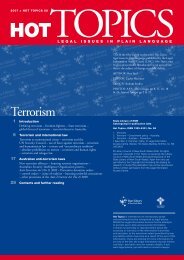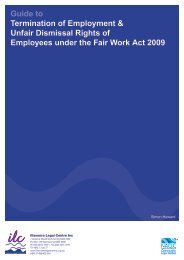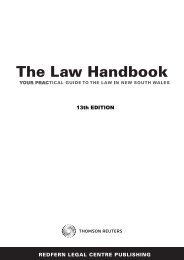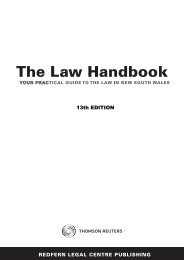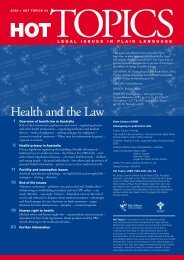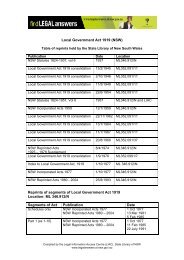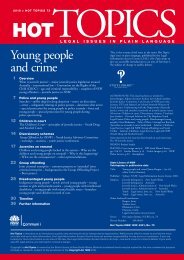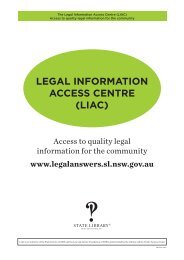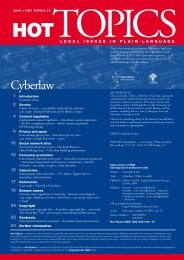TeNaNT daTabaSeSSometimes known as ‘bad tenant databases’ or ‘blacklists’,tenant databases compile personal information abouttenants and applicants collected by their members(mostly real estate agents). The tenant database makesthis information available to all its members, particularlyso that the member can check an applicant for a tenancyagainst the information recorded in the database. Thereare a number of tenant databases operating in NewSouth Wales, and all are private companies.Tenant database operators and real estate agents claimthat tenant databases are a valid risk management toolfor landlords’ agents. Tenant advocates, on the otherhand, argue that tenant databases do not have a validplace in the rental housing system. They say that riskmanagement is better done through checking applicants’references and managing tenancies diligently. They alsopoint to the drastic effect that being listed can have ona person: it can effectively exclude them from rentalhousing and make them homeless.In New South Wales there are two legislative regimesrelating to tenant databases. First is the CommonwealthPrivacy Act 1988 (Cth), which applies through Australia,and in particular the private sector amendments thatcommenced operation in 2002. These amendmentsinclude the National Privacy Principles (NPPs), whichset out requirements for organisations that collectinformation. These include that methods be ‘lawful andfair’, and taking reasonable steps to ensure the personknows information has been collected, and that theinformation is accurate.The Privacy Act 1988 is administered by the Office of theFederal Privacy Commissioner who, among other things,investigates complaints in relation to the NPPs.The second regime is the rule of conduct for real estateagents in the Property, Stock and Business Agents Regulation2003. The circumstances in which an agent may list aperson on a tenant database are set out in Schedule 6A(clause 4(1)). They require there to have been a reasonsuch as serious property damage or money owing, andfor the person to have been given the opportunity torespond to the proposed listing.The rule also provides that agents may only use tenantdatabases that comply with certain standards as set outin Schedule 6A (clause 6).There are a number of problems with the rule. First, itcovers only agents, not private landlords, park operatorsor boarding house owners – or, for that matter, tenantdatabase operators, who can, apparently, list individualsin their own right. Second, the standards for tenantdatabase operators assume that tenant database operatorswill include the reason for a listing in the informationon the database. TICA is currently exploiting thisTica aNd THe Privacy act 1988in 2004, the tenants’ union of Queensland brought arepresentative complaint against the tenant databaseoperator tica for breach of the npps. after aninvestigation, the privacy commissioner determined thattica’s practices breached the npps on 13 separate counts,including that it unlawfully failed to ensure that informationon its databases was accurate, complete and up to date,and that it had charged unlawful fees for access toinformation. tica has had to change its unlawful practices,particularly to allow individuals to enquire, without charge,as to whether they are listed, and to allow access toinformation upon payment of a reasonable charge only (theprivacy commissioner indicated that $32 was the maximumreasonable amount). tica may be liable to compensatepersons who incurred losses as a result of its breaches ofthe npps.however, the privacy commissioner also determined that,except in a few instances, he did not have the powerto make orders specifying how tica is to conduct itsoperations in a way that is consistent with the npps.instead, the privacy commissioner made a series ofrecommendations, including that tica only list people forparticular reasons and for particular time frames. Recently,tica appears to have disregarded these recommendations,and has commenced listing persons without reference toreasons at all.to view case notes and determinations of the Federalprivacy commissioner go to http://www.privacy.gov.au/act/casenotes/index.htmlloophole by not referring to reasons. Third, there is nostraightforward mechanism for resolving disputes: if aperson has a complaint about an agent’s conduct, theycan only provide the information to the <strong>NSW</strong> Officeof Fair Trading for an investigation. If they have acomplaint about a tenant database operator, they musttry to frame their complaint as a complaint against anagent – which may be impossible.TeNaNcy laW refOrmIn 2005, the <strong>NSW</strong> Office of Fair Trading commenceda review of the Residential Tenancies Act 1987, inpreparation for what may be the first comprehensivereform of New South Wales residential tenancy law inalmost 20 years. Some options raised by the Office ofFair Trading included long term leases with a fixed termof 10 years that would allow the parties to contract outof the usual terms of the Residential Tenancies Act 1987,and amendments removing the Tribunal’s discretion todecline to make termination orders where the tenant hasgiven a notice without grounds.Tenants’ advocates have made different recommendationsfor law reform which are available from the Office of FairTrading website www.fairtrading.nsw.gov.au.Residential tenancies 11
Social housingSocial housing in New South Wales comprises the following types of housing:> public housing;> community housing;> Aboriginal housing;> co-operative housing.The first public housing in New South Wales came aboutalmost accidentally, when the government resumed largeparts of the Rocks, including workers’ housing, followingan outbreak of bubonic plague in 1901. A few more orless ad hoc public housing projects were commencedbefore the Second World War, but it was really with theestablishment of the Housing Commission in 1942 that<strong>NSW</strong> commenced a substantial, albeit relatively small,social housing sector. The other parts of the sector arosein the 1970s and 1980s to complement the housingprovided by the Housing Commission and its successor,the Department of Housing.Almost all social housing tenants are covered by theResidential Tenancies Act 1987 (there are only a very fewexceptions, such as residents of boarding houses operatedby social housing landlords). In most respects, socialhousing tenants have the same rights and obligations astenants of private rental housing.The Residential Tenancies Act 1987 does, however, makesome provisions that are specific to social housing. Notall of these special provisions apply to all types of socialhousing. This is because these special provisions usedifferent terms – ‘social housing provider’, ‘social housingpremises’, ‘social housing tenancy agreement’ and ‘publichousing agreement’ – and these terms are not equivalent.In particular, for the purposes of the Residential TenanciesAct 1987 not all ‘social housing providers’ enter into‘social housing tenancy agreements.’Some aspects of social housing – such as decisions abouteligibility, allocations, rent subsidies and transfers – arenot dealt with by the Residential Tenancies Act 1987 orthe Consumer, Trader and Tenancy Tribunal. Thesesorts of matters may be dealt with through the landlord’sown procedures for reviewing decisions, and by theHousing Appeals Committee.public HOuSiNgThe <strong>NSW</strong> Department of Housing dominates therelatively small social housing sector in <strong>NSW</strong> (theDepartment is actually one of the largest social housingproviders in the English-speaking world – a big fish in asmall pond). As well as being the largest landlord, it isalso the main source of funding and the main regulatorfor the other social housing landlords.reSHapiNg public HOuSiNg: TargeTiNg aNd TempOrary TeNurein april 2005, the nsW government announced a platformof reforms called ‘reshaping public housing.’ these reformsincluded:> changes to the eligibility criteria to target assistance topeople with ‘complex housing needs’;> changes to rental subsidies, so that tenants on ‘moderateincomes’ pay up to 30 per cent of their income on rent,‘encouraging’ them to move out;> no security of tenure for new tenants – all new tenantssign fixed term agreements that will be terminated at theend of the fixed term if the tenant’s income is more thanthe ‘moderate’ threshold.as at october 2006, the Department of housing hasintroduced the moderate income rental subsidy rate,and started signing new tenants up on ‘interim’ fixedterm agreements, while it finalises the details of its newpolicies. the Department is also preparing new processesfor applying for public housing and assessing eligibility.the ‘reshaping public housing’ reforms are a response to long-term declines in funding for social housing – the funding under the commonwealth-state housingagreement, the main funding instrument for social housingin australia, has reduced in real terms by 30 per cent since1995-96 – and the relative contraction in the amount ofpublic housing.the reforms are controversial, and have been criticisedon grounds of both equity and effectiveness. critics pointout that public housing is already tightly targeted: evenbefore the new criteria are introduced, almost 97 percent of new public housing tenants have a low income,or special needs, or both 18 . even more precisely targetedeligibility criteria may lead applicants to put themselves atfurther disadvantage in order to get housing. the tenants’union contends that the changes to rents and securityof tenure create work disincentives, and that rather thanencouraging tenants in work to leave housing, the reformswill encourage tenants to leave work in order to stayhoused.18. Report on government services 2006, Chapter 16 – Housing, Productivity Commission, Canberra, 2006;http://www.pc.gov.au/gsp/reports/rogs/2006/housing/index.html.12HOT TOPICS <strong>57</strong> > <strong>Shelter</strong>



